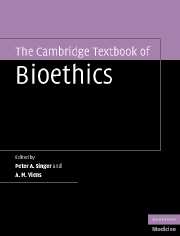Book contents
- Frontmatter
- Contents
- List of contributors
- Acknowledgements
- 1 Introduction
- Section I Information problems
- Section II End of life care
- Section III Pregnant women and children
- Section IV Genetics and biotechnology
- Introduction
- 20 Organ transplantation
- 21 Regenerative medicine
- 22 Genetic testing and screening
- 23 Bio-banking
- 24 Behavioral genetics
- Section V Research ethics
- Section VI Health systems and institutions
- Section VII Using clinical ethics to make an impact in healthcare
- Section VIII Global health ethics
- Section IX Religious and cultural perspectives in bioethics
- Section X Specialty bioethics
- Index
Introduction
Published online by Cambridge University Press: 30 October 2009
- Frontmatter
- Contents
- List of contributors
- Acknowledgements
- 1 Introduction
- Section I Information problems
- Section II End of life care
- Section III Pregnant women and children
- Section IV Genetics and biotechnology
- Introduction
- 20 Organ transplantation
- 21 Regenerative medicine
- 22 Genetic testing and screening
- 23 Bio-banking
- 24 Behavioral genetics
- Section V Research ethics
- Section VI Health systems and institutions
- Section VII Using clinical ethics to make an impact in healthcare
- Section VIII Global health ethics
- Section IX Religious and cultural perspectives in bioethics
- Section X Specialty bioethics
- Index
Summary
This section deals with complex technological issues that we often read about in the media because they are either very new or are controversial. The ethical issues are broad, falling under the umbrella of ELSI (ethical, legal, and social issues) or, for example in Canada, under GE3LS (genetic ethics, environmental, economic, and legal issues).
Chapter 20, deals with traditional organ transplantation, which has been one of the notable biomedical successes of the second half of the twentieth century. It has raised a host of difficult bioethical issues, many of which revolve around organ donation. In the 1980s, it was considered unseemly to consider donation other than from the dead or from genetically related living donors. Today, the range of ethically acceptable potential donors, both cadaveric and living, has expanded substantially in response to the rising need and demand – a measure of transplantation's success. Living donations from spouses and friends are common, and those from acquaintances and even strangers (Good Samaritans) are increasing. Donations from the recently deceased now include the controversial non-heart-beating donors of various types (actually harking back to the early days of cadaveric donation). The two cases discussed in Ch. 20 illustrate a number of important transplant-related issues such as consent, altruism, systems of just allocation of public resources, transplant tourism as well as and other substantive issues.
- Type
- Chapter
- Information
- The Cambridge Textbook of Bioethics , pp. 143 - 144Publisher: Cambridge University PressPrint publication year: 2008
- 1
- Cited by

